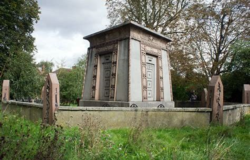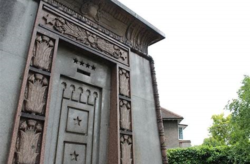Date/Time
Date(s) - Monday 14 February 2022
8:00 pm - 9:00 pm
Location
Duke Street Church
Categories No Categories
A written report, by John Foley, of this talk is included below. There is a also a video recording of Andrew’s talk on the Society’s You Tube channel.
The speaker
Andrew George, who gave us a talk in February 2021 on The gardens of Twickenham Park, is a long-term resident of Richmond and St Margarets. His academic background is as an immunologist, working at Imperial College London. He was Deputy Vice-Chancellor at Brunel University London, and currently supports a number of organisations (in the NHS, academia and charity sector) with research, education and ethics. He is also an executive coach.
Andrew has a MA from Cambridge, a PhD from Southampton and a DSc from Imperial, and was awarded an MBE for his work in research ethics. He has always had an interest in local history, and over the last few years has given a number of talks and walks looking at the characters and gardens associated with St Margarets.
The talk
One of the most colourful people to have lived in this area is Francis Jack Needham, 2nd Earl of Kilmorey (1787–1880). He was a traveller, a sportsman, a builder of houses and a believer in the occult. He is most notorious for eloping with his young ward, Priscilla and, on her death, erecting an Egyptian Mausoleum for her – which he moved with him into his new homes (and can still be seen in St Margarets). Legends and myths are attracted to Kilmorey like bees to the honey pot, but in his case the truth is possibly more unbelievable than the stories.
John Foley reports on Andrew George’s talk
It is a Grade II listed monument, but at first you may struggle to find it; it’s hidden by a plain brick curving wall bordering the footpath of St Margarets Road; only when you know where to look can you see – peeping over the top of this wall – the roof and pillars of an imposing granite-built Victorian (Egyptian-style) mausoleum, abandoned and alone, surrounded by mature trees.
This monument is the tomb of one of Twickenham’s most colourful and eccentric characters, Francis Jack Needham, the 2nd Earl of Kilmorey (pronounced “Kilmurray”, by the way) and his beloved mistress Priscilla Hoste. Born at the family seat in County Down, now Northern Ireland, in 1787 (only later did “Black Jack” inherit the earldom), he certainly lived life to the full; after all, the Kilmorey family motto is Nunc aut numquam (now or never)!
After Eton he followed his father’s example and enlisted in the Army. It was 1806, the time of the Peninsula War, when Britain’s oldiers were fighting Napoleon’s troops in Portugal and northern Spain. Black Jack was serving when the commander, Sir John Moore, was fatally wounded in battle at Corunna. On discharge from the Army Needham was awarded a general service medal. On return to England in 1814, he married his first wife, Jane Gun Cunninghame. The marriage would produce four children, but was not to last, as by the time Black Jack had inherited the earldom he and his wife had separated. They never divorced and Jane lived on until 1857.
What happened next led to the chain of events which resulted in Kilmorey’s Egyptian-style mausoleum coming to St Margarets. Needham had a friend in Sir William Hoste, a successful and famous frigate captain in the Mediterranean, one of Nelson’s proteges. But Hoste, having returned a hero, died from illness contracted during his service, and Kilmorey, his friend, took over wardship of his surviving minor children, one of whom was Priscilla, aged five when her father died. When she was 20, she and Needham, still her guardian and by now 56 – and now also her lover– suddenly eloped abroad. A horror to Victorian sensibility! The couple were traced to Geneva (this was 1844) when Priscilla was found by her mother. As she was still a minor, the Swiss government returned Priscilla, now heavily pregnant, to her mother. There was colourful correspondence between Lady Hoste and the Earl which went public -– and ended not to the benefit of the girl’s mother, whose reputation was sullied, despite a fierce social counter-campaign against the Earl.
The couple returned to England and Priscilla gave birth to a son at Cross Deep House, Twickenham in 1844. We don’t really know what Priscilla looked like, though there is one portrait of a young demure lady which has survived, and which we were told “could be her”. A couple of rather pleasing landscape sketches, attributed to Priscilla, also survive. But the Earl was clearly besotted with her and her child and set up domestic life in Twickenham. In 1851 he was rebuilding Railshead House by the river and you can still see his imprint on it today: note, especially, the letter “K” over the arch of the gatehouse. Indeed, one of the Earl’s passions was buying, doing up – he got involved practically with the rebuilding – and then reselling large houses; locally he got through Cross Deep House (and later on, Sunbury Court and Woburn Park, Weybridge) and he was building St Margarets House as the “dream” home for him and Priscilla. But, in 1851, tragedy struck; Priscilla died of a cardiac disorder, leaving the Earl desolate. So, instead of the dream home, came the dream tomb. Designed and built in pink and white granite in Egyptian style by Henry Kendall at the huge cost of £30,000, the mausoleum was capable of being transhipped in pieces, and followed Kilmorey around in later years to his subsequent residences, coming finally to rest at St Margarets when he was living at Gordon House. In 1880, the Earl died aged 93. He was buried in the tomb vault beside his beloved Priscilla. He had long before acquired the reputation of frequenting nocturnally her tomb alone, access from his residence of the time being by means of secret hidden tunnels.
But, until its end, the Earl’s fascinating life continued. He married again, aged almost 80. His many interests were wide and extravagant; he loved to travel and owned hotels in Canada and Switzerland. He was a keen rower and is reputed to have rowed the river from Oxford to London in 14 hours, a team of supporters running ahead to clear locks in advance for him. He was friendly with the Clasper family in Tyneside (a very famous rowing family) and organised competitions with their Tyneside team, including in such races well known rowers as Hammerton and Tagg (rowing being very popular then).
In spite of dressing for dinner in a bluecoat and brass buttons, in contrast to his jet-black hair and dark complexion, he was modest in his appetite and drank little alcohol. A man of passion, but of control too, he watched what he ate and constantly weighed his food, He was known to be generous, funding an annual trip for his staff to the Alhambra Theatre in central London (and walking back with them on an occasion when they had all missed the last train.) He also generously resettled abroad a butler who apologised profusely after admitting stealing from him a large sum of money. He was keen on gardening, kept a monkey and an aviary full of exotic birds and once even posted a snake for his menagerie.
Andrew George gave more detail (far too much to go in this short report) so do go onto the RLHS YouTube video recording to replay the excellent lecture in full. Members of the second Earl’s descendants were present in the hall (and on Zoom), including the current (sixth) Earl, Sir Richard Francis Needham, a former MP for Chippenham and former Government minister, who shared some insights on the widespread Kilmorey descendants of the second Earl, and was warm in his praise for Andrew’s research and talk. The sixth Earl can be seen in an interview on YouTube. And if you want to visit the Kilmorey tomb, it does open to the public occasionally by grace of its current guardians, Habitats and Heritage.



